A few From The " COLD WAR" 1947–1991 Pt. 1
Sat Oct 18, 2014 5:31 pm
All photos are from the U.S.F.G., unless otherwise noted.
I have not been posting a lot of photos, like I used to do, I had someone ask about "Cold War" pics, well here ya go, this is part 1, more later, & I ain't no Jack Cook!
No Special Order To Follow:
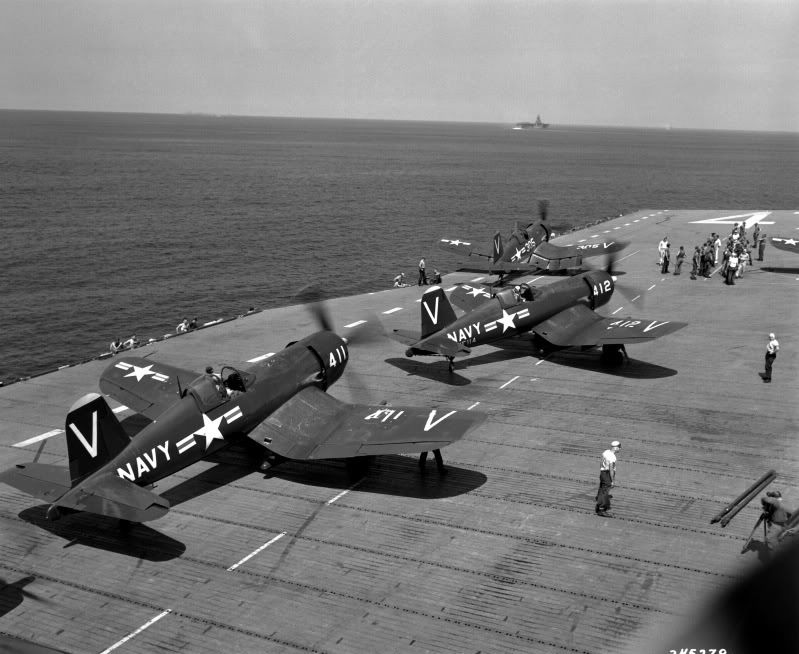
: Vought F4U-4 Corsair fighters of U.S. Navy fighter squadrons VF-114 Executioners (V-4XX) and VF-113 Stingers (V-3XX, on the catapult), assigned to Carrier Air Group 11 (CVG-11), on the aircraft carrier USS Philippine Sea (CV-47) during the Korean War in 1951/52. Another Essex-class carrier of Task Force 77 is visible in the background.
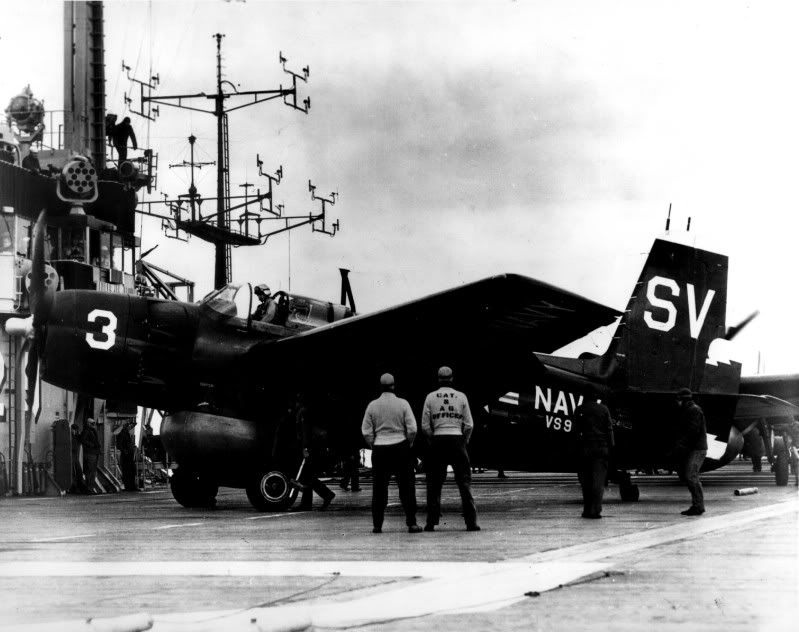
A U.S. Navy Grumman AF-2W Guardian of anti-submarine squadron VS-931 on the deck of the light aircraft carrier USS Bataan (CVL-29), circa 1951. The squadron had been established as U.S. Naval Reserve composite squadron VC-931 in 1948. It was activated as VS-931 on 1 March 1951 and redesignated VS-20 on 4 February 1953.
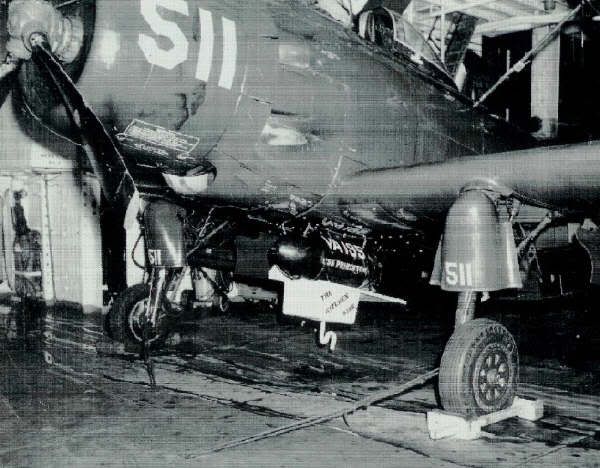
A U.S. Navy Douglas AD-4 Skyraider of attack squadron VA-195 Dambusters with a special ordnance aboard the aircraft carrier USS Princeton (CVA-37) in August 1952. VA-195 was assigned to Carrier Air Group 19 (CVG-19) for a deployment to the Korean War from 21 March to 3 November 1952. The "special weapon" was a 454 kg (1000 lb) bomb with a kitchen sink attached. The idea came up, when the squadron's executive officer LCdr. M.K. Dennis remarked during a meeting with the press: "We dropped everything on them (the North Koreans) but a kitchen sink." Royal J. Deland, ADC, and J. Burnett, ADC, then produced a bomb with a kitchen sink attached. Obviously the commanding Admiral was not pleased by this and would not allow to drop the bomb for a week. However, press coverage in the United States obviously led to the dropping of this bomb in August 1952 on Pyongyang by Lt.(jg) Carl B. Austin.[1] Date August 1952
-
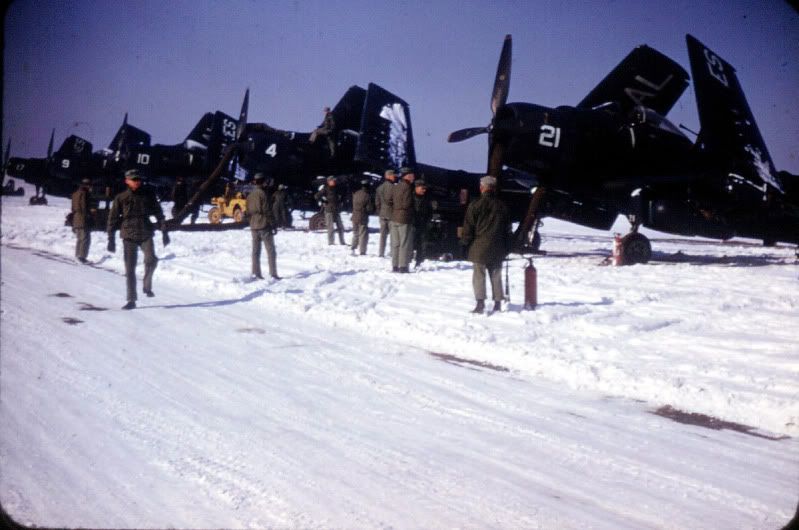
Douglas AD-4 Skyraider attack planes of U.S. Marine Corps attack squadron VMA-251 Thunderbolts at Pyongtaek airfield (K-6), South Korea, in 1953/54
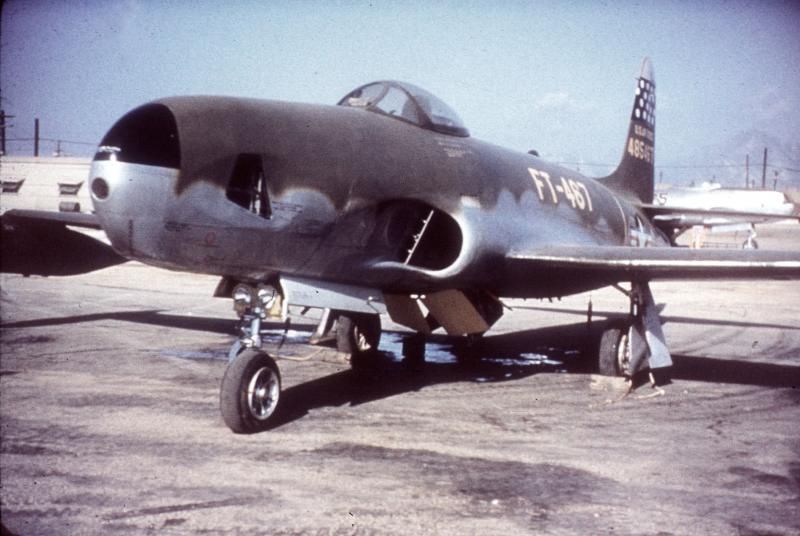
A U.S. Air Force Lockheed RF-80A-5-LO Shooting Star (s/n 44-85467) from the 45th Tactical Reconnaissance Squadron, 67th Tactical Reconnaissance Wing in Korea. The squadron was based at Taegu in 1950-51 and at Kimpo for the remainder of the war. A few RF-80s received an experimental olive drab paint job to be less visible to MiG fighters. -
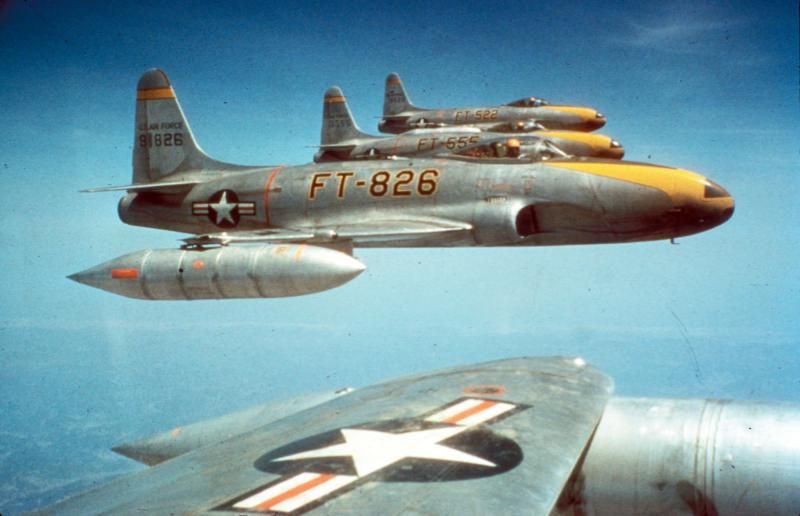
U.S. Air Force Lockheed F-80C Shooting Star fighters from the 8th Fighter-Bomber Squadron, 49th Fighter-Bomber Group, during the Korean War, in 1950-51. The aircraft are equipped with "Misawa' long range tanks. -
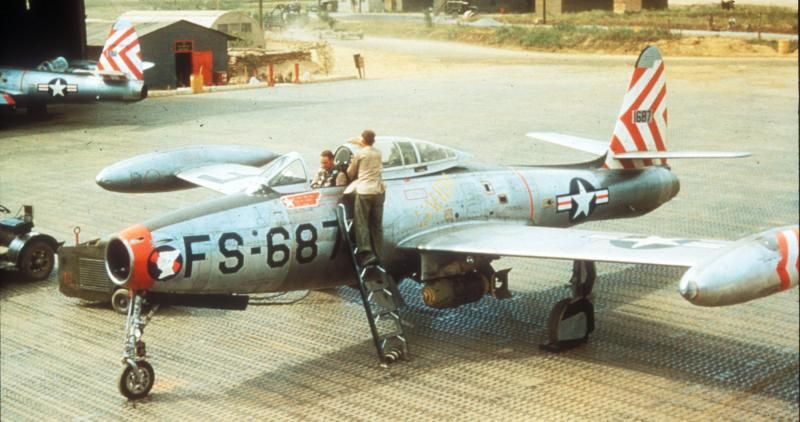
A U.S. Air Force F-84 crew chief cleans the canopy as the pilot straps in before a mission. The Republic F-84E-30-RE Thunderjet (s/n 51-687) was assigned to the 9th Fighter-Bomber Squadron, 49th Fighter-Bomber Wing, and was shot down by MiG-15s on 9 September 1952. The pilot Captain Warren O'Brien is missing in action.
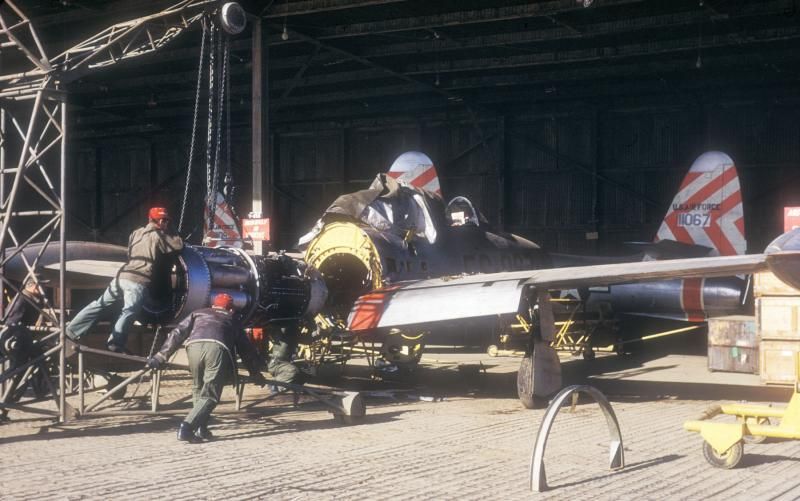
Maintenance on a U.S. Air Force Republic F-84G-10-RE Thunderjet fighter (s/n 51-1067) from the 430th Fighter-Bomber Squadron, 474th Fighter-Bomber Group, at Taegu Air Base (K-2), Korea, in February 1954. Obviously the Allison J35-A-29 turbojet had been removed. Note the aircraft's tail section in the background.
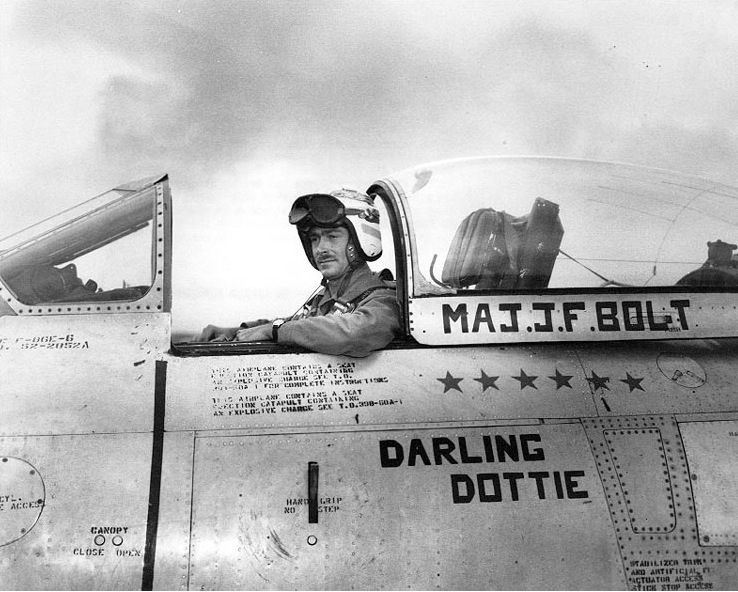
Maj. John F. Bolt, the USMC's first "Jet Ace", in F-86, 1953: Seated in a U.S. Air Force F-86E "Sabre" jet fighter. This plane is an F-86E-6, serial # 52-2852. Note pilot's name painted on the canopy frame, with victory stars and nickname "Darling Dottie" painted below. Photo is dated 13 July 1953, two days after Major Bolt shot down his fifth and sixth MiG-15s to become the only U.S. Marine Corps air "Ace" of the Korean War. He achieved the aerial victories while flying with the 5th Air Force as an exchange pilot. The original caption states: "Major Bolt, who shot down six Japanese planes during World War II, has flown 89 jet fighter-bomber missions with the 1st Marine Aircraft Wing, which has been assigned only close support and interdiction missions in Korea. He has flown 37 Saberjet sweeps with the 5th Air Force, which is carrying the air war to the MiGs.
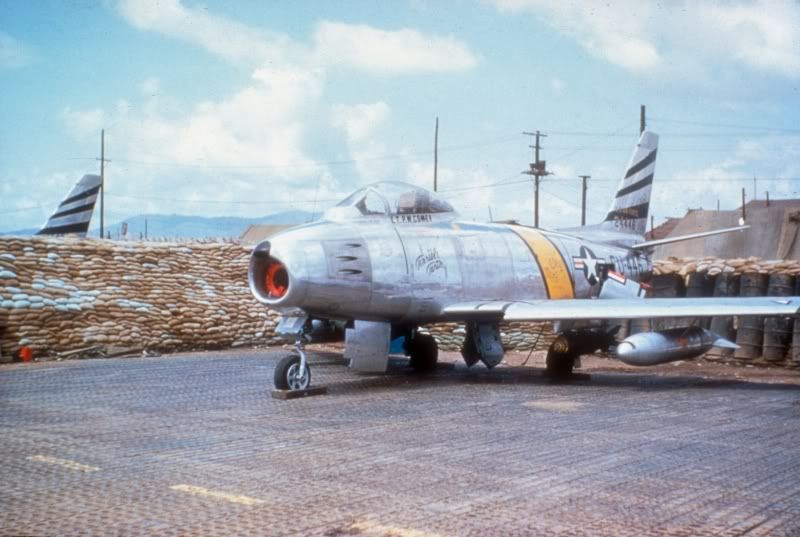
A U.S. Air Force North American F-86F-30-NA Sabre (s/n 52-4446), nicknamed "Terrible Turtle" of the 35th Fighter-Bomber Squadron, 8th Fighter-Bomber Wing, flown by 1st Lt. Perrin W. Gower, in Korea. Date ca. 1953
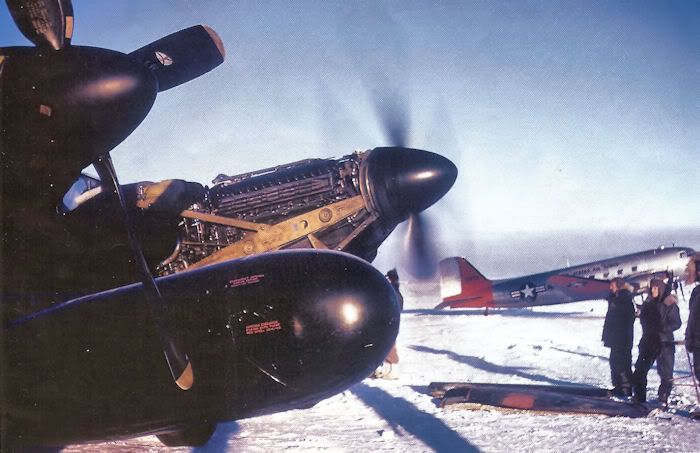
Engine maintence at Ladd AFB on an F-82, Winter 1951
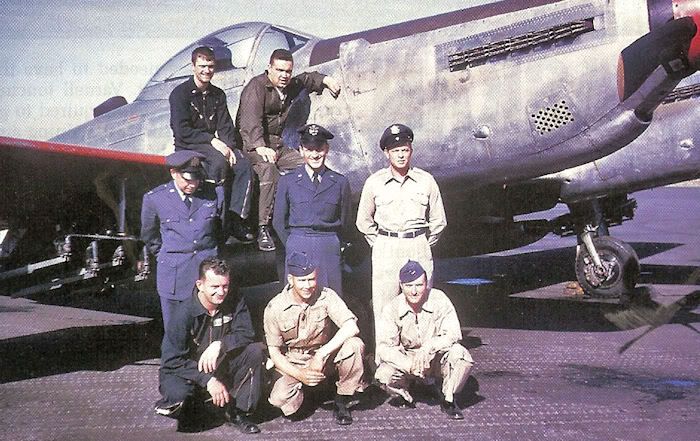
The last flight crew and ground support personel for the F-82 Twin Mustang, Ladd AFB, 1953
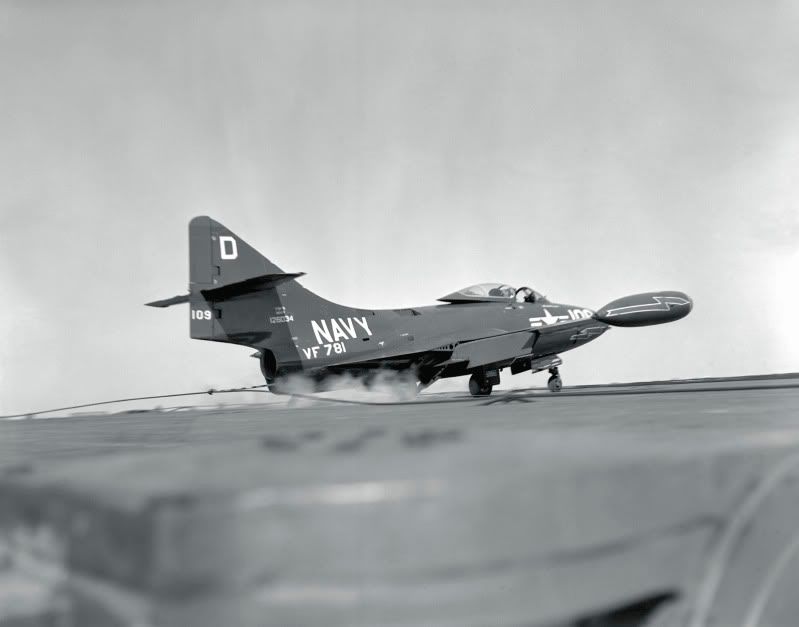
Lt. Joseph J. MacBrien, an exchange pilot from the Royal Canadian Navy, serving with the U.S. Navy fighter squadron VF-781, lands his Grumman F9F-5 Panther (BuNo 126034) aboard the aircraft carrier USS Oriskany (CVA-34) off coast of Korea on 15 November 1952. VF-781 was assigned to Carrier Air Group 101 for a deployment to Korea from 15 September 1952 to 18 May 1953 -
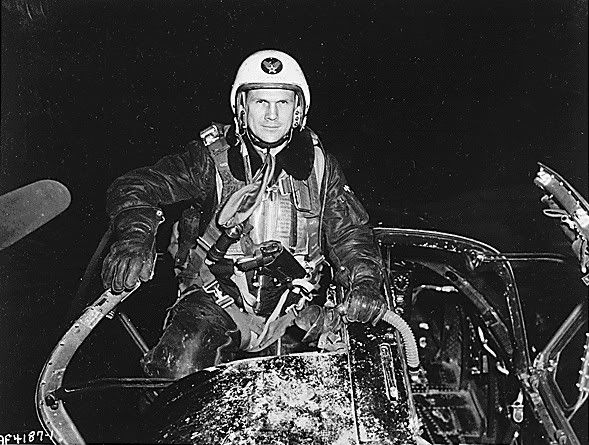
USAF Captain Frank W. Crobett of the 17th Bomb Wing (Light) climbing out of his Douglas B-26 Invader after his last combat mission, April 1953. Original caption: "FIFTH AIR FORCE, KOREA--Capt. Frank W. Corbett, 726 First Ave., Gadsen, Ala., climbs out of his U.S. Air Force 17th Bomb Wing B-26 "Invader" after his final combat mission over North Korea , ca. 04/1953" -
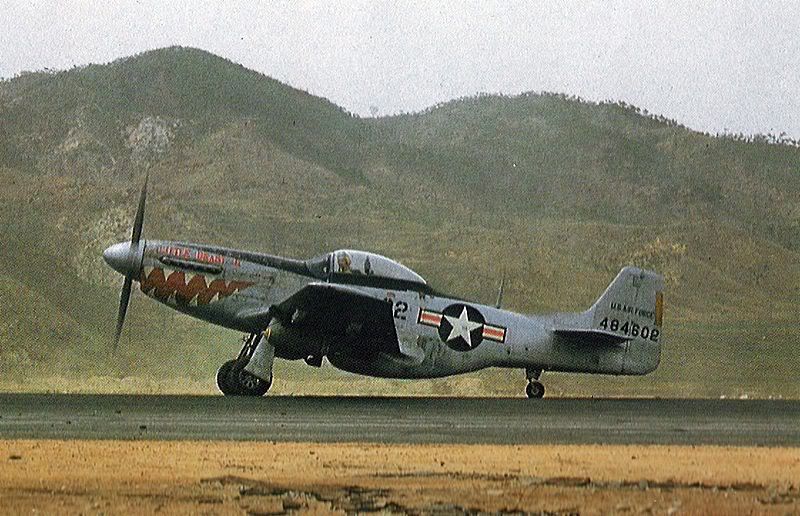
A U.S. Air Force North American F-51D-25-NT Mustang fighter (s/n 44-84602) of the 12th Fighter-Bomber Squadron, 18th Fighter-Bomber Group, nicknamed "Little Beast IV" (?), about to take off from Chinhae, Korea, sometime between 9 December 1950 and 2 June 1952. -

Douglas AD-4 "Skyraider" attack planes from USS Valley Forge (CV-45), fire 5-inch rockets at a North Korean field position. The Skyraiders belonged to attack squadron VA-55 Torpcats of Carrier Air Group Five (CVG-5).[1] Photo is dated 24 October 1950. -
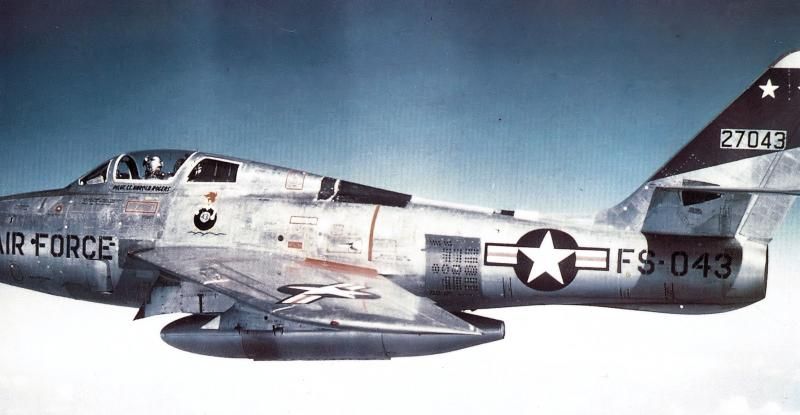
407th SFW F-84F Thunderstreak 52-7043, Great Falls AFB, Montana, 1955 -
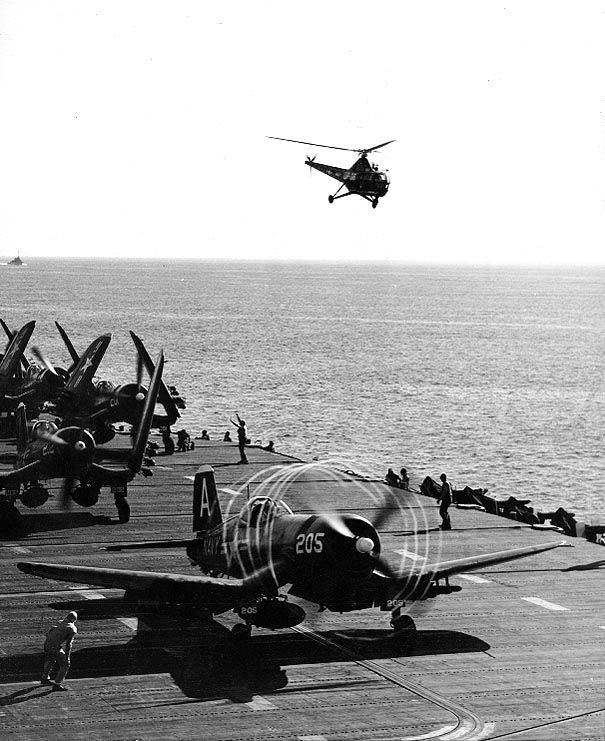
A Vought F4U-4 Corsairs of fighter squadron VF-791 Fighting Falcons launching from the U.S. aircraft carrier USS Boxer (CV-21) in 1951 during a deployment to Korea. The Sikorsky HO3S-1 plane guard helicopter of helicopter utility squadron HU-1 Det. F Pacific Fleet Angels is standing by. Original description: "Deck Launch -- Visible rings of vapor encircle a Corsair fighter as it turns up prior to being launched from the USS Boxer for a strike against communist targets in Korea. Hovering to the stern of the aircraft carrier, the every-present helicopter plane guard stands by to assist if any emergency arises." Date 1951
I guess that's about it for now, stand by for part 2 tomorrow.
Robbie
I have not been posting a lot of photos, like I used to do, I had someone ask about "Cold War" pics, well here ya go, this is part 1, more later, & I ain't no Jack Cook!
No Special Order To Follow:

: Vought F4U-4 Corsair fighters of U.S. Navy fighter squadrons VF-114 Executioners (V-4XX) and VF-113 Stingers (V-3XX, on the catapult), assigned to Carrier Air Group 11 (CVG-11), on the aircraft carrier USS Philippine Sea (CV-47) during the Korean War in 1951/52. Another Essex-class carrier of Task Force 77 is visible in the background.

A U.S. Navy Grumman AF-2W Guardian of anti-submarine squadron VS-931 on the deck of the light aircraft carrier USS Bataan (CVL-29), circa 1951. The squadron had been established as U.S. Naval Reserve composite squadron VC-931 in 1948. It was activated as VS-931 on 1 March 1951 and redesignated VS-20 on 4 February 1953.

A U.S. Navy Douglas AD-4 Skyraider of attack squadron VA-195 Dambusters with a special ordnance aboard the aircraft carrier USS Princeton (CVA-37) in August 1952. VA-195 was assigned to Carrier Air Group 19 (CVG-19) for a deployment to the Korean War from 21 March to 3 November 1952. The "special weapon" was a 454 kg (1000 lb) bomb with a kitchen sink attached. The idea came up, when the squadron's executive officer LCdr. M.K. Dennis remarked during a meeting with the press: "We dropped everything on them (the North Koreans) but a kitchen sink." Royal J. Deland, ADC, and J. Burnett, ADC, then produced a bomb with a kitchen sink attached. Obviously the commanding Admiral was not pleased by this and would not allow to drop the bomb for a week. However, press coverage in the United States obviously led to the dropping of this bomb in August 1952 on Pyongyang by Lt.(jg) Carl B. Austin.[1] Date August 1952
-

Douglas AD-4 Skyraider attack planes of U.S. Marine Corps attack squadron VMA-251 Thunderbolts at Pyongtaek airfield (K-6), South Korea, in 1953/54

A U.S. Air Force Lockheed RF-80A-5-LO Shooting Star (s/n 44-85467) from the 45th Tactical Reconnaissance Squadron, 67th Tactical Reconnaissance Wing in Korea. The squadron was based at Taegu in 1950-51 and at Kimpo for the remainder of the war. A few RF-80s received an experimental olive drab paint job to be less visible to MiG fighters. -

U.S. Air Force Lockheed F-80C Shooting Star fighters from the 8th Fighter-Bomber Squadron, 49th Fighter-Bomber Group, during the Korean War, in 1950-51. The aircraft are equipped with "Misawa' long range tanks. -

A U.S. Air Force F-84 crew chief cleans the canopy as the pilot straps in before a mission. The Republic F-84E-30-RE Thunderjet (s/n 51-687) was assigned to the 9th Fighter-Bomber Squadron, 49th Fighter-Bomber Wing, and was shot down by MiG-15s on 9 September 1952. The pilot Captain Warren O'Brien is missing in action.

Maintenance on a U.S. Air Force Republic F-84G-10-RE Thunderjet fighter (s/n 51-1067) from the 430th Fighter-Bomber Squadron, 474th Fighter-Bomber Group, at Taegu Air Base (K-2), Korea, in February 1954. Obviously the Allison J35-A-29 turbojet had been removed. Note the aircraft's tail section in the background.

Maj. John F. Bolt, the USMC's first "Jet Ace", in F-86, 1953: Seated in a U.S. Air Force F-86E "Sabre" jet fighter. This plane is an F-86E-6, serial # 52-2852. Note pilot's name painted on the canopy frame, with victory stars and nickname "Darling Dottie" painted below. Photo is dated 13 July 1953, two days after Major Bolt shot down his fifth and sixth MiG-15s to become the only U.S. Marine Corps air "Ace" of the Korean War. He achieved the aerial victories while flying with the 5th Air Force as an exchange pilot. The original caption states: "Major Bolt, who shot down six Japanese planes during World War II, has flown 89 jet fighter-bomber missions with the 1st Marine Aircraft Wing, which has been assigned only close support and interdiction missions in Korea. He has flown 37 Saberjet sweeps with the 5th Air Force, which is carrying the air war to the MiGs.

A U.S. Air Force North American F-86F-30-NA Sabre (s/n 52-4446), nicknamed "Terrible Turtle" of the 35th Fighter-Bomber Squadron, 8th Fighter-Bomber Wing, flown by 1st Lt. Perrin W. Gower, in Korea. Date ca. 1953

Engine maintence at Ladd AFB on an F-82, Winter 1951

The last flight crew and ground support personel for the F-82 Twin Mustang, Ladd AFB, 1953

Lt. Joseph J. MacBrien, an exchange pilot from the Royal Canadian Navy, serving with the U.S. Navy fighter squadron VF-781, lands his Grumman F9F-5 Panther (BuNo 126034) aboard the aircraft carrier USS Oriskany (CVA-34) off coast of Korea on 15 November 1952. VF-781 was assigned to Carrier Air Group 101 for a deployment to Korea from 15 September 1952 to 18 May 1953 -

USAF Captain Frank W. Crobett of the 17th Bomb Wing (Light) climbing out of his Douglas B-26 Invader after his last combat mission, April 1953. Original caption: "FIFTH AIR FORCE, KOREA--Capt. Frank W. Corbett, 726 First Ave., Gadsen, Ala., climbs out of his U.S. Air Force 17th Bomb Wing B-26 "Invader" after his final combat mission over North Korea , ca. 04/1953" -

A U.S. Air Force North American F-51D-25-NT Mustang fighter (s/n 44-84602) of the 12th Fighter-Bomber Squadron, 18th Fighter-Bomber Group, nicknamed "Little Beast IV" (?), about to take off from Chinhae, Korea, sometime between 9 December 1950 and 2 June 1952. -

Douglas AD-4 "Skyraider" attack planes from USS Valley Forge (CV-45), fire 5-inch rockets at a North Korean field position. The Skyraiders belonged to attack squadron VA-55 Torpcats of Carrier Air Group Five (CVG-5).[1] Photo is dated 24 October 1950. -

407th SFW F-84F Thunderstreak 52-7043, Great Falls AFB, Montana, 1955 -

A Vought F4U-4 Corsairs of fighter squadron VF-791 Fighting Falcons launching from the U.S. aircraft carrier USS Boxer (CV-21) in 1951 during a deployment to Korea. The Sikorsky HO3S-1 plane guard helicopter of helicopter utility squadron HU-1 Det. F Pacific Fleet Angels is standing by. Original description: "Deck Launch -- Visible rings of vapor encircle a Corsair fighter as it turns up prior to being launched from the USS Boxer for a strike against communist targets in Korea. Hovering to the stern of the aircraft carrier, the every-present helicopter plane guard stands by to assist if any emergency arises." Date 1951
I guess that's about it for now, stand by for part 2 tomorrow.
Robbie

Re: A few From The " COLD WAR" 1947–1991 Pt. 1
Sun Oct 19, 2014 9:43 am
Cool stuff. It'd be so great to see Panthers and F-84s flying today.
Chappie
Chappie
Re: A few From The " COLD WAR" 1947–1991 Pt. 1
Sun Oct 19, 2014 5:00 pm
If I had the money I would love to recreate an F-80 from a T-33, assuming there are no F-80s available.
Re: A few From The " COLD WAR" 1947–1991 Pt. 1
Sun Oct 19, 2014 7:37 pm
John Dupre wrote:If I had the money I would love to recreate an F-80 from a T-33, assuming there are no F-80s available.
Between the Registry and Wikipedia, there seem to be 14½ survivors in the U.S. (the ½ is the forward fuselage of 44-85391 at the Air Victory Museum in New Jersey), one each in Brazil and Peru, plus the former Soplata TO-1 at Pensacola; POF has a nice one on display at Chino but I don't know it they intend to make it a flyer.
BIG edit: Should have checked millionmonkeytheater.com first; webmaster Nathan Decker has turned up 42½ of the darn things (although he lists four as questionable): http://www.millionmonkeytheater.com/P-80.html
Re: A few From The " COLD WAR" 1947–1991 Pt. 1
Sun Oct 19, 2014 11:55 pm
Just now found this one dated January 5, 1955 from the Historic Photographs of Southwest Louisiana archive:
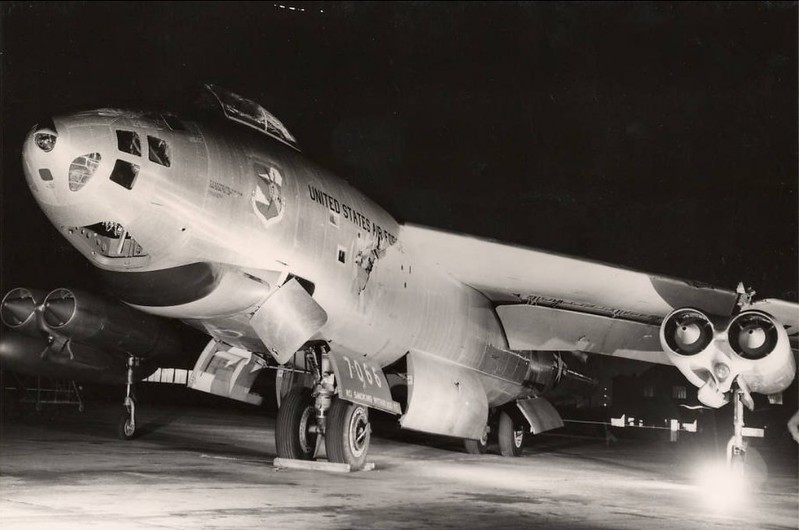
That buzz number on the gear door indicates this is B-47E 51-7066:
http://www.warbirdregistry.org/jetregis ... 17066.html
Just checked Baugher again; looks like the other B-47E wasn't so lucky:

"Lake Charles Air Force Base, Lake Charles, Louisiana... After colliding with a sister aircraft over the Gulf of Mexico 26 miles from Cameron, Louisiana, the above B-47 Stratojet returned to Lake Charles AFB. The two Stratojets were on a routine mission when the mishap occurred. Observer of the aircraft, 1st Lt. Matthew Genery, was ejected from the plane and parachuted into the Gulf. The two crew members returning with the planes are: Major Sterling P. Carroll, aircraft commander and Captain Morris E. Shiver, pilot."
That buzz number on the gear door indicates this is B-47E 51-7066:
7066 to WB-47E. Restored to SAC configuration and now on display at Museum of Flight, Seattle, WA.
http://www.warbirdregistry.org/jetregis ... 17066.html
Just checked Baugher again; looks like the other B-47E wasn't so lucky:
(52-)029 crashed in Louisiana Jan 5, 1955
Re: A few From The " COLD WAR" 1947–1991 Pt. 1
Mon Oct 20, 2014 3:25 pm
If I had the money I would love to recreate an F-80 from a T-33, assuming there are no F-80s available.
Jim Ricketts of Aero Nostalgia, Stockton, Ca converted a T-33 to an F-80 configuration for an exchange to the USAF in the 1980's...